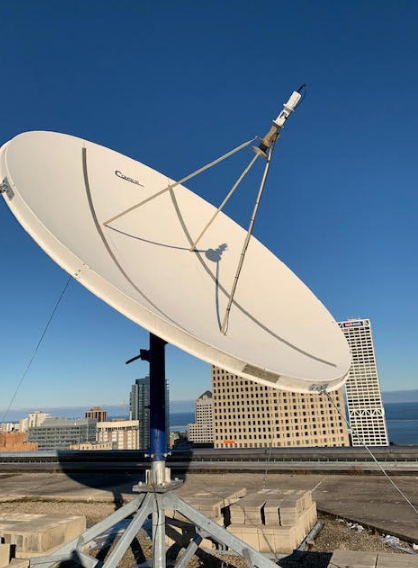The cut-off frequency is the lowest frequency at which a transmission line supports signal propagation, calculated using 𝑓𝑐=𝑣𝑝2⋅𝑑f c = 2⋅dv p .
Determination
The cut-off frequency is a critical parameter for efficient system performance without any signal loss for any communication system, such as satellite transmissions and television broadcasting. In fact, the cut-off frequency is the lowest frequency at which a signal can travel through a transmission line or waveguide without substantial attenuation or loss to the output. When the engineers design the coaxial cable for use with consumer electronics such as home internet routers, it often ensures that the cut-off frequency is as per the specifications and bandwidth requirements of the service. For instance, if a cable service provides internet at speeds up to 1Gbps, the cut-off frequency of the coaxial cable must be high enough to support these frequencies, typically in the GHz range.
For a coaxial cable with a phase velocity of about 2×1082×108 meters per second, and a distance of 2.5 mm between the inner conductor and the shield, fc\displaystyle f_{c}$ would be approximately equal to 40 GHz. The phase velocity is around two-thirds the speed of light. It can be calculated using the formula 𝑓𝑐=𝑣𝑝2⋅𝑑fc=2⋅dvp . In this formula, 𝑣𝑝vp and 𝑑d is the diameter of the inner conductor.
The formula allows the engineers to experimentally determine the cut-off frequency by tweaking their cable designs accordingly. In fact, this formula implies that if the distance between the conductors is decreased, then the cut-off frequency would increase, in turn. This is beneficial for higher-frequency applications, such as 5G networks, as the cut-off frequency of the coaxial cable will be increased to match such higher frequencies. In addition to this, the right materials can significantly increase the cut-off frequency. For instance, the electromagnetic property of the materials in the transmission line determines the phase velocity. Dielectric materials with lower er\displaystyle er dielectric constants allow for higher phase velocities, which, in turn, increase the cut-off frequency as a direct result of the transmission speed and efficiency of these calculated signals.

Phase Velocity
Phase velocity is an important factor in the operation and effectiveness of transmission lines. It describes how quickly the phase of the electromagnetic wave is moving down the line. Effectively, it defines the propriety of signal transmission over a large distance, as is the case with telecommunications and broadcasting networks. In the example of a telecommunications company setting up a fiber-optic network, understanding phase velocity allows optimizing the performance efficiency. Fiber-optic cables are known for the rapid and efficient transmission of data. As such, it can be expected that the phase velocity will be close to the speed of the light, which is approximately 3×1083×108 meters per second. This increased phase velocity also implies a higher cut-off frequency, which allows the network to support services with high data rates, such as HD video services and high-speed internet access .
In the case of an old coaxial cable used with traditional broadband service, it has an inherently lower phase velocity because of the differences in electric material. The phase velocity of the typical coaxial cable is 2×1082×108 meters per second, which also affects a lower cut-off frequency. This lower frequency limits the services that the cutoff is able to support and the overall performance quality. As such, the relationship between phase velocity and the cut-off frequency is typically used by engineers to design cables to different specifications. Thus, for instance, upgrading the cable from a standard coaxial cable to an improved version insulated with high-density polyethylene, allows increasing the phase velocity. This, in turn, increases the cut-off frequency, and therefore, the frequency range that can be supported by the cable . This factor is most relevant in the case of high-frequency trading, as sometimes the difference of one millisecond can determine the success of a trade. If the high-speed data connection in a network is built from materials that maximize the phase velocity, the network will have the minimum delay.
Importance in Waveguides
The most prominent factor in how waveguides operate and how successfully different frequencies of waves can be guided by the structure is the cut-off frequency. Waveguides, in contrast to most other transmission lines, are employed in high-frequency applications to a large extent, including radar systems, satellite communications, and microwave links. Therefore, these structures need to have sufficient control over the propagation of the bands that are employed in each application. The cut-off frequency is therefore vital in the design of various devices, including microwave ovens. Microwave ovens function by passing waves with 2.45 GHz frequency, as this is the frequency that is absorbed in water molecules in food effectively . The waveguide must therefore have a cut-off frequency below this level, in order to effectively guide the 2.45 GHz waves and ensure relatively limited signal loss .
In many cases, the cut-off frequency can be manipulated by adjusting the dimensions and materials used to design waveguides. A larger waveguide, other factors being equal, will depict a lower cut-off frequency. This is advantageous when guiding lower frequency waves, as with the example of 2.45 GHz waves used in microwave ovens. The dimensions of a standard waveguide are typically such that the cut-off frequency is around 2 GHz, which is significantly lower than the frequency that is guided. Therefore, the guide proposed for use in a microwave oven would guide 2.45 GHz waves with excellent efficiency and relatively limited signal loss. This was achieved by using dimensions that cause a cut-off frequency of the guide at or around 2 GHz . The dimensions of waveguides can be deliberately set to obtain the necessary cut-off frequency for every waveguide design. In the case of satellite communications, waveguides that are used in transmitting signals from ground stations to satellites must be designed with a cut-off frequency that matches the allocated satellite transmission band . This can be done by deliberately choosing the waveguide dimensions in such a way that the cut-off frequency, in this case, falls in the frequency squat. For example, a C-band feed waveguide would typically operate in the 4 – 8 GHz frequency band . Similarly, the more powerful Ku-band would use 12 – 18 GHz waveguides .

Mode Dependency
The cut-off frequency that corresponds to a transmission line or waveguide greatly depends on the mode of wave propagation. Mode dependency is a critical element that engineers must consider so that they can design their systems for specific applications: the result will be an efficient system’s operation on specific frequencies. In the telecommunications industry, for example, the same fiber-optic cable can support multiple modes of transmission, each with its cut-off frequency. The fiber-optic fundamental mode of propagation is responsible for the base performance of the fiber. However, with the help of higher-order modes, configurations can transport additional data streams at higher cut-off frequencies. Suddenly, the same cable can have several modes, each of which has its own cut-off frequency and carry additional data streams, thus increasing the cable and network capacity. The same practice applies to multiple lines and multi-mode fibers.
Provided are two examples of practical applications related to the specified industry:
-
Practical Application for Broadband Data Transmission Service. The engineers decide to use multi-mode fiber-optic cables to increase data transmission rates within the city limit for broadband internet services. The designed cable might have the fundamental mode at 850 nm, but other modes carry additional data streams at 1300 nm: the combination is still at work within the commercial windows of fiber-optic communication.
-
Practical Application in Aerospace and Radar Systems. Engineers also can study mode dependency to design radar systems and aerospace products such as waveguides. Engineers also make sure that the rectangular waveguide operates in the TE10 mode at the X-band frequency range: this application guarantees that a rectangular waveguide operates at its cut-off frequency of approximately 6.56 GHz, which allows the radar system to receive the highest possible range and resolution. To ensure that such operation happens within an air-filled waveguide, engineers adjust their dimensions accordingly.






